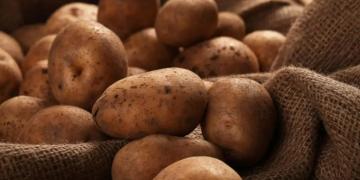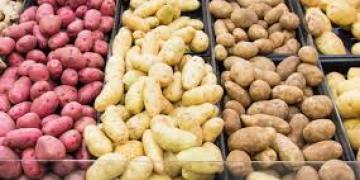EEUU: This Modern Farmer Wants You to Grow a New Potato Strain
Also known as Johnny Potato Seed, this small farmer turned a plot of land in Wisconsin into the epicenter of an international potato breeding movement.

At 30 years old, Curzio Caravati moved to the United States from Switzerland, settling into the lakeside town of Kenosha, WI, where he purchased two acres of land and began filling it with crops. It was 1995, and Caravati raised all sorts of produce, though he focused mainly on potatoes. Now, nearly three decades later, his small plot of land has become the nucleus of a worldwide potato breeding movement.
Caravati had grown potatoes, as well as other crops, for many years, but it wasn’t until he read Michael Pollan’s book, The Botany of Desire, that he realized potato plants could also produce berries. After some additional research, Caravati discovered just how significant these unusual little fruits could be. It was this revelation that inspired him to found the Kenosha Potato Project (KPP) in 2007. Although first intended as a simple Facebook group to share his efforts on growing potatoes in containers, KPP quickly grew into an online community of thousands of both novice and experienced potato growers from around the world. At the center of this quickly growing community is the humble potato berry.
Some varieties of self-pollinating potato or those whose flowers can cross pollinate with other varieties growing in close vicinity will produce small green berries, similar in appearance to an unripe cherry tomato. But, unlike cherry tomatoes, these inconspicuous fruits are not fit for consumption. Much like the vines and leaves of the potato plant, these berries contain solanine, a toxic substance, making them inedible. But these berries are still incredibly valuable. Each holds hundreds of tiny seeds, capable of producing an entirely new variety of potato.
Potatoes originated in the Andes Mountains of South America and, while there are nearly 5,000 varieties still grown there, only about 100 distinct potato cultivars are grown in the United States. Most commercial potatoes are grown by planting seed potatoes, which are actually just small potatoes or cut pieces of tubers that have already begun forming stem nodes or “eyes.” The harvested potatoes produced through this method are clones of the original seed potato; they are genetically identical. This is useful for large-scale commercial production, since all of the tubers will be a uniform size and will be ready for harvest at the same time.
On the other hand, fields of genetically identical crops can easily become more susceptible to pest and disease pressures. One needs only to look back at the Irish Potato Famine of the late 1840s to see how quickly a plant disease can decimate a crop. Additionally, the environmental concerns of our changing climate also threaten the future of large-scale commercial potato farming. Potatoes do not grow well in the hot, dry conditions that have become so common in recent years. While scientists are busy researching new varieties that can adapt to temperature changes, Caravati and his Kenosha Potato Project are offering a grassroots solution, utilizing the most traditional form of plant breeding available: seed saving.
The seeds found inside of the potato berry, also known as True Potato Seed (TPS) or botanical seed, could be the key to developing new potato varieties that not only survive in our changing climate but even thrive in it. Most varieties of potato are tetraploid, meaning that they have four sets of chromosomes, unlike most plants or animals, which have two. This extra set of chromosomes results in at least four times as many possible combinations of genetic traits passed down into each seed. Simply put, this means that each seed within the berry will produce a new, genetically unique potato variety.
“All known potato varieties started with TPS”, says Caravati. “The most famous heirloom variety is Early Rose, which grew by chance in a field from a volunteer seed.” The Early Rose potato is a variety originally grown by Albert Bresee of Hubbardton, Vermont in the early 1860s. It still remains a popular cultivar today for its resistance to blight and common pests.
Through the use of TPS, growers can breed new potato varieties for any traits that they might desire such as heat tolerance, disease resistance and long-term storability. But selections can also be made for color, size and shape. According to William Whitson, a plant breeder and long-time member of KPP, “Most people who grow from TPS aren’t focused on breeding a better potato; they are focused on breeding a better potato for themselves, for their conditions, interests and tastes.”
KPP member Rick Machado has developed a heat- and drought-resistant potato at his farm in southern California using TPS. “With conventional breeding techniques, we can create new potatoes that will produce well in heat, drought and poor soil conditions,” he says. Machado dubbed this resilient new potato “Isla.” It has since been shared with Agriculture and Agri-Food Canada, which is researching Isla’s potential for large-scale commercial farming.
In Rhode Island, KPP member Nathan Pierce has worked with the greenhouse club at his daughter’s high school to grow long-season potatoes that students can harvest in the fall. Their variety can tolerate pest pressure from Colorado potato beetles. “That has been very fun to see and to be a part of,” says Pierce.
To encourage farmers and gardeners to try their hand at growing potatoes with botanical seed, Caravati and the Kenosha Potato Project have launched what they call “TPS Trains.” Novice growers join a mailing list to have samples of seed sent to them. The Beginner’s Train is open to everyone in the United States interested in participating, while the Advanced Train requires participants to donate TPS from their own gardens to be distributed as well. This has proven to be such a successful method to distribute seeds and encourage new potato growers that a similar exchange system has recently started for Canadian growers as well.
Since its inception 16 years ago, KPP has connected and inspired growers from 120 different countries, who have created countless varieties of potatoes. “Potatoes are grown everywhere,” says Caravati, “and the Kenosha Potato Project is my way to help the world enjoy the diversity and beauty of potatoes grown from true botanical seed.”
Fuente: https://modernfarmer.com/2023/01/true-potato-seed/




